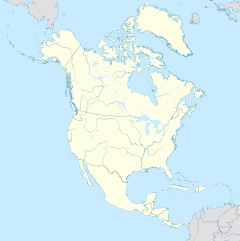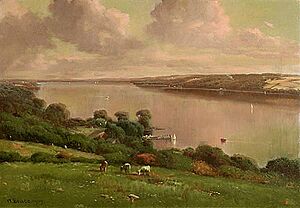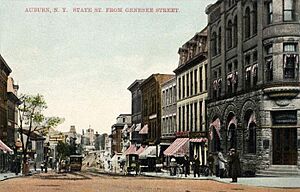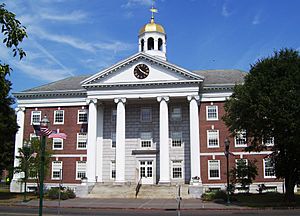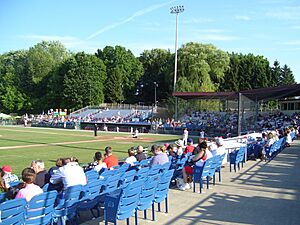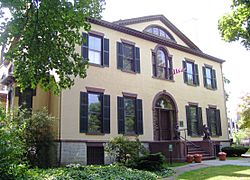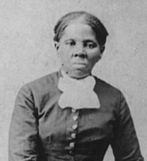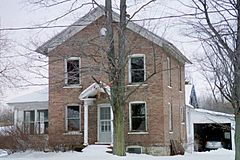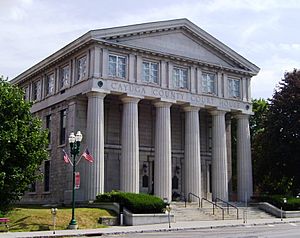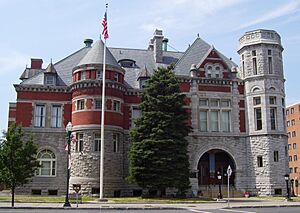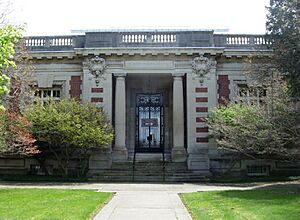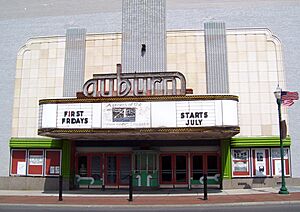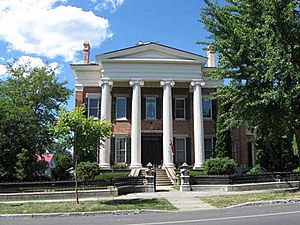Auburn, New York facts for kids
Quick facts for kids
Auburn
|
|
|---|---|

North side of Genesee Street in downtown Auburn
|
|
| Nickname(s):
Prison City
|
|
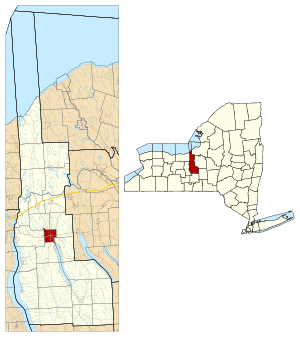
Location in Cayuga County and the state of New York.
|
|
| Country | United States |
| State | New York |
| County | Cayuga |
| Incorporated | 1815 (village) 1848 (city) |
| Government | |
| • Type | Council-Manager |
| Area | |
| • Total | 8.41 sq mi (21.78 km2) |
| • Land | 8.34 sq mi (21.59 km2) |
| • Water | 0.08 sq mi (0.20 km2) |
| Elevation | 686 ft (209 m) |
| Population
(2020)
|
|
| • Total | 26,866 |
| • Density | 3,223.28/sq mi (1,244.46/km2) |
| Time zone | UTC-5 (Eastern (EST)) |
| • Summer (DST) | UTC-4 (EDT) |
| ZIP codes |
13021
|
| Area code(s) | 315 |
| FIPS code | 36-011-03078 |
| GNIS feature ID | 0942692 |
Auburn is a city in Cayuga County, New York, United States. It is located at the north end of Owasco Lake. This lake is one of the Finger Lakes in Central New York. In 2020, the city had a population of 26,866 people. Auburn is the largest city in Cayuga County and its main government center. It is also home to the Auburn Correctional Facility, the William H. Seward House Museum, and the house of abolitionist Harriet Tubman.
Contents
History of Auburn
For many centuries before Europeans arrived, the land around Auburn belonged to the Haudenosaunee people.
Auburn was started in 1793. This was after the American Revolution, when many new settlements were being built in western New York. The founder was John L. Hardenbergh. He was a soldier who fought in the Sullivan-Clinton campaign. This campaign was against the Iroquois during the American Revolution. Some Haudenosaunee groups had sided with the British. General George Washington ordered the Sullivan Campaign to stop Haudenosaunee forces. This campaign destroyed many Native communities.
After the war, Hardenbergh received land in the area. He settled near the Owasco River with his baby daughter and two enslaved African-Americans, Harry and Kate Freeman. The community grew around Hardenbergh's mills. Harry and Kate Freeman were later freed. Kate was freed in 1805, and Harry was freed shortly after Hardenbergh's death in 1806.
The settlement was first called Hardenbergh's Corners. In 1805, it was renamed Auburn and became the county seat. It became an official village in 1815 and a city in 1848. The Erie Canal opened nearby in 1825. This helped local factories ship their goods cheaply. Later, in 1871, a railroad line was built. It helped carry coal from Pennsylvania through Auburn to Lake Ontario.
From 1818 to 1939, Auburn had the Auburn Theological Seminary. This was an important school for religious studies. Due to money problems during the Great Depression, the seminary moved to New York City. Today, only the Willard Memorial Chapel and Welch Memorial Hall remain. The chapel has beautiful stained-glass windows and decorations by Louis Comfort Tiffany. It is the only complete Tiffany chapel interior known to exist.
In 1816, Auburn Prison was built. It is now called the Auburn Correctional Facility. It was a new kind of prison at the time. People could pay to visit and see the prisoners. On August 6, 1890, the first use of the electric chair happened at Auburn Prison. In 1901, a man named Leon Czolgosz, who had harmed President William McKinley, was also executed there. The prison is still a very secure facility today.
Geography of Auburn
Auburn is located at the northern end of Owasco Lake. This lake is one of the Finger Lakes. The Owasco Outlet, also known as the Owasco River, flows north through the city from the lake. It then goes into the Seneca River. A dam in the city controls the water flowing out of the lake. This water is used for drinking and fun activities.
The city covers about 8.4 square miles (21.8 km2) of land and water. Most of this, about 8.3 square miles (21.6 km2), is land.
US 20 is a major highway that goes through Auburn from east to west. New York State Route 34 and New York State Route 38 are north-south highways that cross US-20 in Auburn. Seneca Falls is about 15 miles (24 km) west on US 20. Syracuse is about 26 miles (42 km) northeast via New York State Route 5.
Climate in Auburn
Auburn has a climate with big temperature changes throughout the year. Summers are warm to hot and often humid. Winters are cold, sometimes very cold. This type of weather is called a humid continental climate.
| Climate data for Auburn, New York (1991–2020 normals, extremes 1897–present) | |||||||||||||
|---|---|---|---|---|---|---|---|---|---|---|---|---|---|
| Month | Jan | Feb | Mar | Apr | May | Jun | Jul | Aug | Sep | Oct | Nov | Dec | Year |
| Record high °F (°C) | 70 (21) |
74 (23) |
85 (29) |
92 (33) |
95 (35) |
101 (38) |
100 (38) |
98 (37) |
99 (37) |
94 (34) |
78 (26) |
68 (20) |
101 (38) |
| Mean maximum °F (°C) | 55.1 (12.8) |
53.1 (11.7) |
64.0 (17.8) |
79.7 (26.5) |
86.1 (30.1) |
91.0 (32.8) |
91.9 (33.3) |
90.8 (32.7) |
87.9 (31.1) |
78.6 (25.9) |
68.1 (20.1) |
56.7 (13.7) |
93.9 (34.4) |
| Mean daily maximum °F (°C) | 31.3 (−0.4) |
33.4 (0.8) |
41.6 (5.3) |
55.2 (12.9) |
68.6 (20.3) |
76.9 (24.9) |
81.1 (27.3) |
79.7 (26.5) |
72.4 (22.4) |
59.4 (15.2) |
47.5 (8.6) |
36.8 (2.7) |
57.0 (13.9) |
| Daily mean °F (°C) | 23.3 (−4.8) |
24.7 (−4.1) |
32.1 (0.1) |
44.6 (7.0) |
56.9 (13.8) |
66.2 (19.0) |
70.7 (21.5) |
69.1 (20.6) |
61.9 (16.6) |
50.3 (10.2) |
39.5 (4.2) |
29.9 (−1.2) |
47.4 (8.6) |
| Mean daily minimum °F (°C) | 15.4 (−9.2) |
16.0 (−8.9) |
22.7 (−5.2) |
34.0 (1.1) |
45.2 (7.3) |
55.4 (13.0) |
60.4 (15.8) |
58.5 (14.7) |
51.5 (10.8) |
41.2 (5.1) |
31.6 (−0.2) |
23.1 (−4.9) |
37.9 (3.3) |
| Mean minimum °F (°C) | −5.5 (−20.8) |
−2.7 (−19.3) |
3.7 (−15.7) |
21.7 (−5.7) |
31.2 (−0.4) |
41.5 (5.3) |
49.2 (9.6) |
48.1 (8.9) |
37.5 (3.1) |
27.9 (−2.3) |
16.5 (−8.6) |
4.2 (−15.4) |
−8.9 (−22.7) |
| Record low °F (°C) | −20 (−29) |
−32 (−36) |
−16 (−27) |
6 (−14) |
25 (−4) |
33 (1) |
40 (4) |
39 (4) |
28 (−2) |
16 (−9) |
−1 (−18) |
−21 (−29) |
−32 (−36) |
| Average precipitation inches (mm) | 2.93 (74) |
2.48 (63) |
3.23 (82) |
3.68 (93) |
3.77 (96) |
4.10 (104) |
4.31 (109) |
4.26 (108) |
3.87 (98) |
4.47 (114) |
3.59 (91) |
3.57 (91) |
44.26 (1,124) |
| Average snowfall inches (cm) | 29.1 (74) |
25.9 (66) |
17.2 (44) |
3.1 (7.9) |
0.2 (0.51) |
0.0 (0.0) |
0.0 (0.0) |
0.0 (0.0) |
0.0 (0.0) |
0.4 (1.0) |
8.8 (22) |
24.7 (63) |
101.6 (258) |
| Average precipitation days (≥ 0.01 in) | 19.0 | 15.6 | 14.6 | 15.2 | 14.3 | 13.6 | 12.7 | 11.6 | 10.8 | 17.2 | 16.0 | 19.6 | 180.2 |
| Average snowy days (≥ 0.1 in) | 13.9 | 12.1 | 7.1 | 2.0 | 0.2 | 0.0 | 0.0 | 0.0 | 0.0 | 0.5 | 4.6 | 11.9 | 52.3 |
| Source: NOAA | |||||||||||||
People in Auburn
| Historical population | |||
|---|---|---|---|
| Census | Pop. | %± | |
| 1810 | 500 | — | |
| 1820 | 2,333 | 366.6% | |
| 1830 | 4,486 | 92.3% | |
| 1840 | 5,626 | 25.4% | |
| 1850 | 9,548 | 69.7% | |
| 1860 | 10,986 | 15.1% | |
| 1870 | 17,225 | 56.8% | |
| 1880 | 21,924 | 27.3% | |
| 1890 | 25,858 | 17.9% | |
| 1900 | 30,345 | 17.4% | |
| 1910 | 34,668 | 14.2% | |
| 1920 | 36,192 | 4.4% | |
| 1930 | 36,652 | 1.3% | |
| 1940 | 35,753 | −2.5% | |
| 1950 | 36,722 | 2.7% | |
| 1960 | 35,249 | −4.0% | |
| 1970 | 34,599 | −1.8% | |
| 1980 | 32,548 | −5.9% | |
| 1990 | 31,258 | −4.0% | |
| 2000 | 28,574 | −8.6% | |
| 2010 | 27,687 | −3.1% | |
| 2020 | 26,866 | −3.0% | |
| U.S. Decennial Census | |||
In 2000, there were 28,574 people living in Auburn. There were 11,411 households. About 28% of households had children under 18. The average household had 2.27 people. The average family had 2.98 people.
The population included people of different ages. About 22.8% were under 18. About 17.8% were 65 or older. The average age was 37 years.
Education in Auburn
The Auburn Enlarged City School District runs the public schools in Auburn. It has seven schools for students from kindergarten to 12th grade.
The only college in Auburn is Cayuga Community College. It is a two-year school. It is often called C.C.C. by local people.
Sports in Auburn
Professional Baseball
Auburn has a long history with professional baseball. Many different teams have played here over the years. These include the Auburn Cayugas and other early teams. They were part of various leagues.
Today, Auburn is home to the Auburn Doubledays. This team plays in the Perfect Game Collegiate Baseball League. This league uses wooden bats.
Minor League Baseball Headquarters
In 1901, Auburn became the main office for the National Association of Professional Baseball Leagues. This organization is now called Minor League Baseball. Its offices stayed in Auburn for many years.
Auburn Community Baseball
Auburn Community Baseball owns the Auburn Doubledays team. The city of Auburn owns this organization. The team plays its home games at Leo Pinckney Field at Falcon Park.
The Great Race
Since 1978, Auburn has hosted "The Great Race" every August. It is a relay race with three or four people on a team. The race includes running, cycling, and canoeing or kayaking. It starts and ends near Owasco Lake. This race is very popular. Between 2,000 and 2,500 people usually take part. It is one of the biggest relay races in the United States.
Media in Auburn
The local daily newspaper in Auburn is The Citizen. It started in 1816. It covers news for Auburn and Cayuga County. It is published seven days a week.
Famous People from Auburn
Two of the most well-known historical figures linked to Auburn are Harriet Tubman and William H. Seward.
Seward lived in Auburn from 1823 until he passed away in 1872. He was a New York state senator and the governor of New York. He also served as a U.S. senator. Later, he became Secretary of State for presidents Abraham Lincoln and Andrew Johnson. In this role, he helped buy Alaska from Russia in 1867. This was sometimes called "Seward's Folly." Seward was against slavery.
Seward's wife, Frances Adeline Seward, strongly supported the movement to end slavery. Auburn was a big supporter of this movement. In the 1850s, the Seward family opened their home. It was a safe place for people escaping slavery on the Underground Railroad. In 1859, Seward sold land to Harriet Tubman. She used it to create a safe home for her family and friends. It also helped other black Americans seeking a better life in the north.
Today, Seward's house is a history museum. Both his house and Tubman's house are listed as important historical places.
Other Notable People
- Willard Bundy: He invented the first time clock.
- Theodore Case: He helped create the first successful way to record sound on film.
- Birdsill Holly: He is thought to have invented the fire hydrant.
- Abner Doubleday: He was a general. For many years, people believed he created baseball.
- Samuel Hopkins Adams: He was an author.
- John Walsh: He is known for hosting TV shows like America's Most Wanted.
Businesses in Auburn
- Auburn Bearing & Manufacturing: This company started in 1898. It designs and makes parts for machines called ball and roller thrust bearings.
Historic Places to Visit
Many places in Auburn are listed on the National Register of Historic Places. These include the Auburn Button Works and Logan Silk Mills and the Belt-Gaskin House. Other sites are the Case Memorial-Seymour Library and the Cayuga County Courthouse and Clerk's Office.
You can also visit the Harriet Tubman Home for the Aged and the William and Mary Hosmer House. The St. Peter's Episcopal Church Complex and Sand Beach Church are also listed. The Schines Auburn Theatre and Thompson AME Zion Church are important. Don't forget the Harriet Tubman Grave and Harriet Tubman House.
Other historic spots include the Old Post Office and Courthouse. Also, Fort Hill Cemetery, Wall Street Methodist Episcopal Church, and Dr. Sylvester Willard Mansion. The William H. Seward House and Willard Memorial Chapel-Welch Memorial Hall are very important national landmarks. The South Street Area Historic District is a national historic area.
In 2018, the NYS Equal Rights Heritage Center opened. It is a visitor center. It has an exhibit about the region's history and culture. It helps visitors find historical sites. These sites are connected to the fight for equal rights.
See Also
 In Spanish: Auburn (Nueva York) para niños
In Spanish: Auburn (Nueva York) para niños




